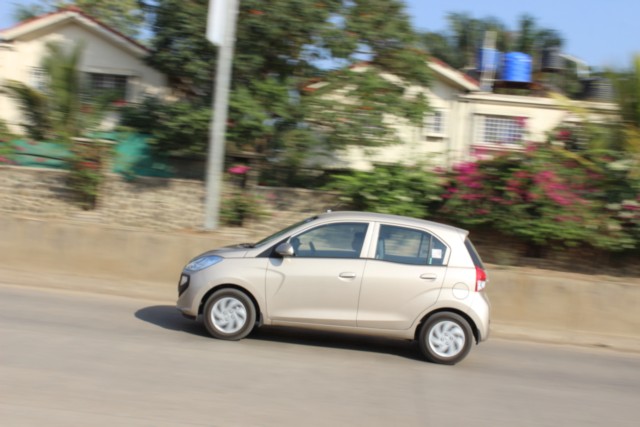
Get going and the Santro immediately pleasantly surprises with its refinement. The engine is the same Epsilon 1.1-litre, 12-valve, four-cylinder unit. In here, it makes 69 PS and 99 Nm, enough for the city and the occasional highway jaunt. Among the highlights, though, is the automated manual transmission (AMT) unit that Hyundai have developed in-house. The shift quality is smoother and more predictable compared to any conventional AMT I’ve driven by other suppliers.
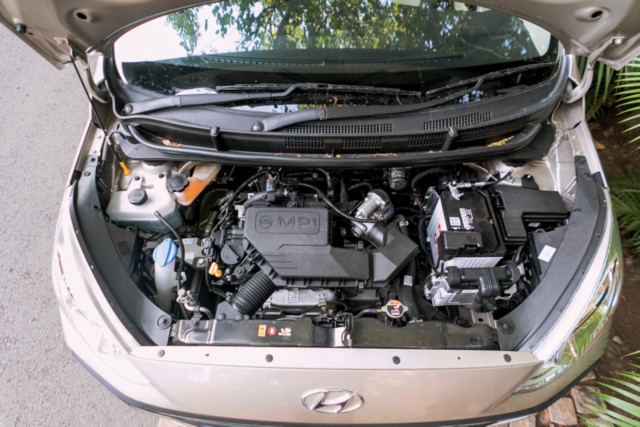
The demeanour the Santro inspires is that of a calm runabout, with no urge to speed or pare through traffic. Push it, though, and it can go. The shift from first to second is a bit slow, but it catches on well and doesn’t disappoint. It’s as good as any torque converter transmission with its shift logic making me wonder what the other big names have been doing. Give it a heavy foot and it revs up to the red-line before shifting up. Even so, a 0-60 km/h time of 8.8 seconds isn’t all that bad. The fuel efficiency it showed at this point was around 15 km/litre, compared to its indicated 19+ km/l highway figure. The steering feel is good and it feels nice to drive. The suspension is almost magical and soaks up all kinds of rough patches and smothers pot-holes. The dynamics on rebound are astounding and the strut front/torsion beam rear just plant the wheels down for commendable road manners at city speeds. The 0-100 km/h time of 19-plus seconds, and its behaviour at speed make it better suited to the city.
There is evident body-roll at highway speeds and it is quite squeamish on the brakes, too. While the stopping distances and times are good, the way it comes to a stop isn’t. From 100 km/h to zero and even from 80 to zero, it was quite dramatic and slamming on the brakes is not recommended. Gradual, planned deceleration is best. ABS is standard, yes, but there was an issue maintaining directional stability. Another annoying aspect is the windscreen wipers need to be manually activated to wipe after the washer has been used. Pulling the left stalk just activates the spray and leaves it there. Both stalks, too, are further away from the wheel than I would have liked. The right stalk is also missing a lane-change indicator – where a quick flick for three blinks would have been welcome.
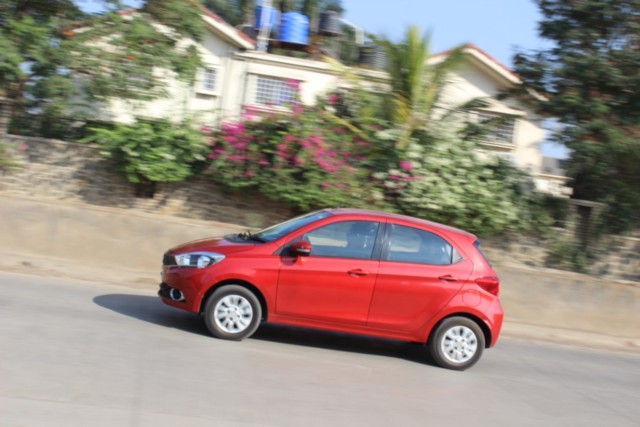
The Tiago shines in the handling department. Where the Santro is amazing in the city, the Tiago is capable everywhere. The suspension may not have the magical damping skills of the Santro, but it does a good job. The Tiago shone in the city and on the highway, feeling sure-footed and totally planted even when taking a long bend at the highway speed limit. It’s reassuring and rather fun to drive and the 1.2-litre, four-valves-per-cylinder, three-pot does a good job of making usable power and torque, both of which – 85 PS and 114 Nm – are higher than the Santro. However, where it loses out is the shift quality of the AMT box, which doesn’t hold a candle to the Korean unit in terms of shift logic. The runs to 60 km/h and then 100 km/h are quicker, though, at 7.99 seconds and 17.6 seconds respectively, but it’s the way it gets there that disappoints.
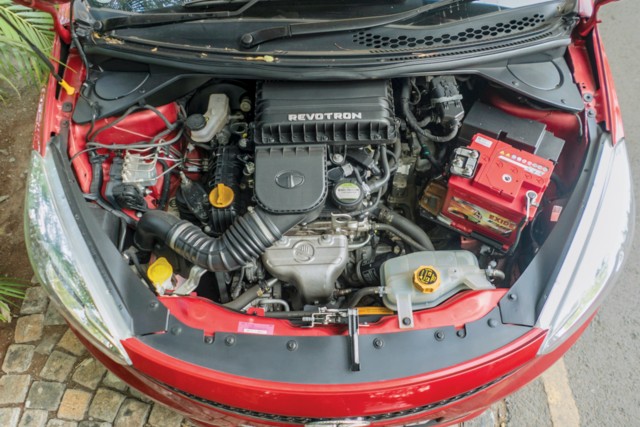
The lull in between shifts is telling and precious momentum is lost in the process. This isn’t just at triple-figure speeds. When climbing up a slope on the return into town, the Tiago AMT selected first for the climb, which it proceeded to do at part throttle at 25 km/h. Suddenly, it decided to select second while half way up, leading to a sudden slow down and an almost stationary car mid-slope. Not good. And it’s not this unit, in particular, all of the other ones I’ve sampled are equally flummoxed at times, whether paired to a popular diesel four-pot in a French example or many a Japanese compact – another aspect that highlights Hyundai’s progress. The Tiago also has a Sport mode, but pushing that ‘S’ button and then pushing the car’s performance led to a peculiar “burning” smell that was all too familiar to me from another car model with the same feature. Best stay in ‘City’ mode. There’s also a “Creep” function which helps crawl in traffic and does not bring on Radiohead on the audio. Fuel efficiency, too, was around the 13 km/l mark in and around the city.
All things considered, the Tiago is a capable all-rounder, if you can excuse the AMT habits, and handles brilliantly at all speeds, whether city or highway.
Now, the difficult bit. How do you choose? Well, the simple answer is the very advice I give everyone before they decide on a car: test drive them both back-to-back and see which suits your needs and driving style better. The Santro is a fantastic city car, but, without a top-spec Asta Smart Auto, the Sportz variant loses out on some important kit, including rear parking sensors and the reverse camera, auto door locks, a rear wiper and a passenger airbag. However, there is an undeniable high-quality feel to it and it shows that Hyundai haven’t compromised. The Tiago is loaded with more kit, for an asking price of about Rs 25,000 more. Though it doesn’t have a colour display or a camera to offer, audio-visual parking warnings are present and enough. No car, even with another zero in the price tag is perfect. It’s always a matter of the right compromise and narrowing down the features that truly matter to you. With worsening city traffic and stop-and-go jams in every major city, an automatic transmission adds to convenience in a big way. There are two petrol variants for each of these two: the Santro has Magna Auto and Sportz Auto trims at Rs 5.19 lakh and Rs 5.47 lakh (ex-showroom) respectively, while the Tiago has the Revotron XTA and XZA at Rs 5.09 lakh and Rs 5.71 lakh respectively. The Santro has a definite edge in terms of quality fit-and-finish, sound insulation, and ride comfort. Besides, the shift quality of Hyundai’s in-house AMT is unmatched even by larger, more expensive cars.
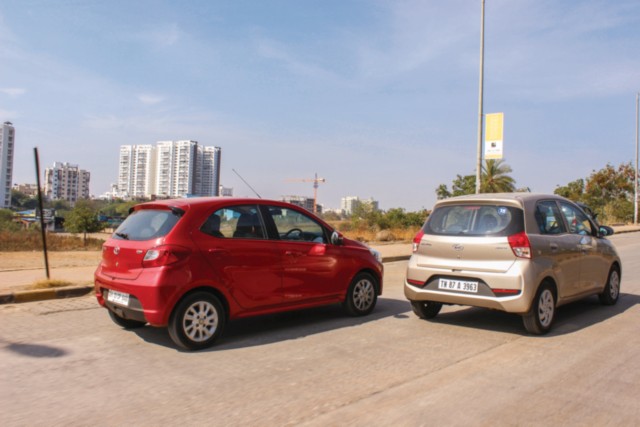


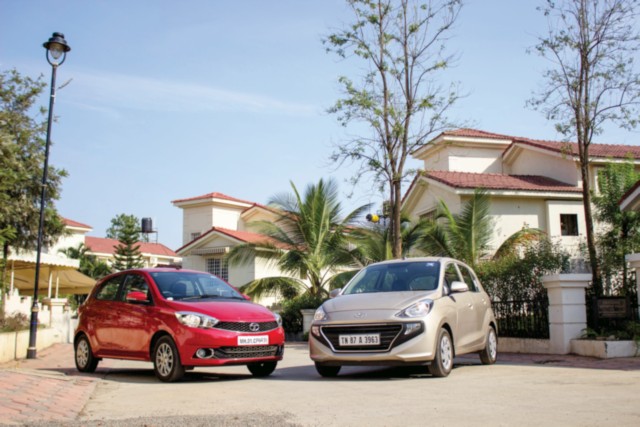


















Leave a Reply